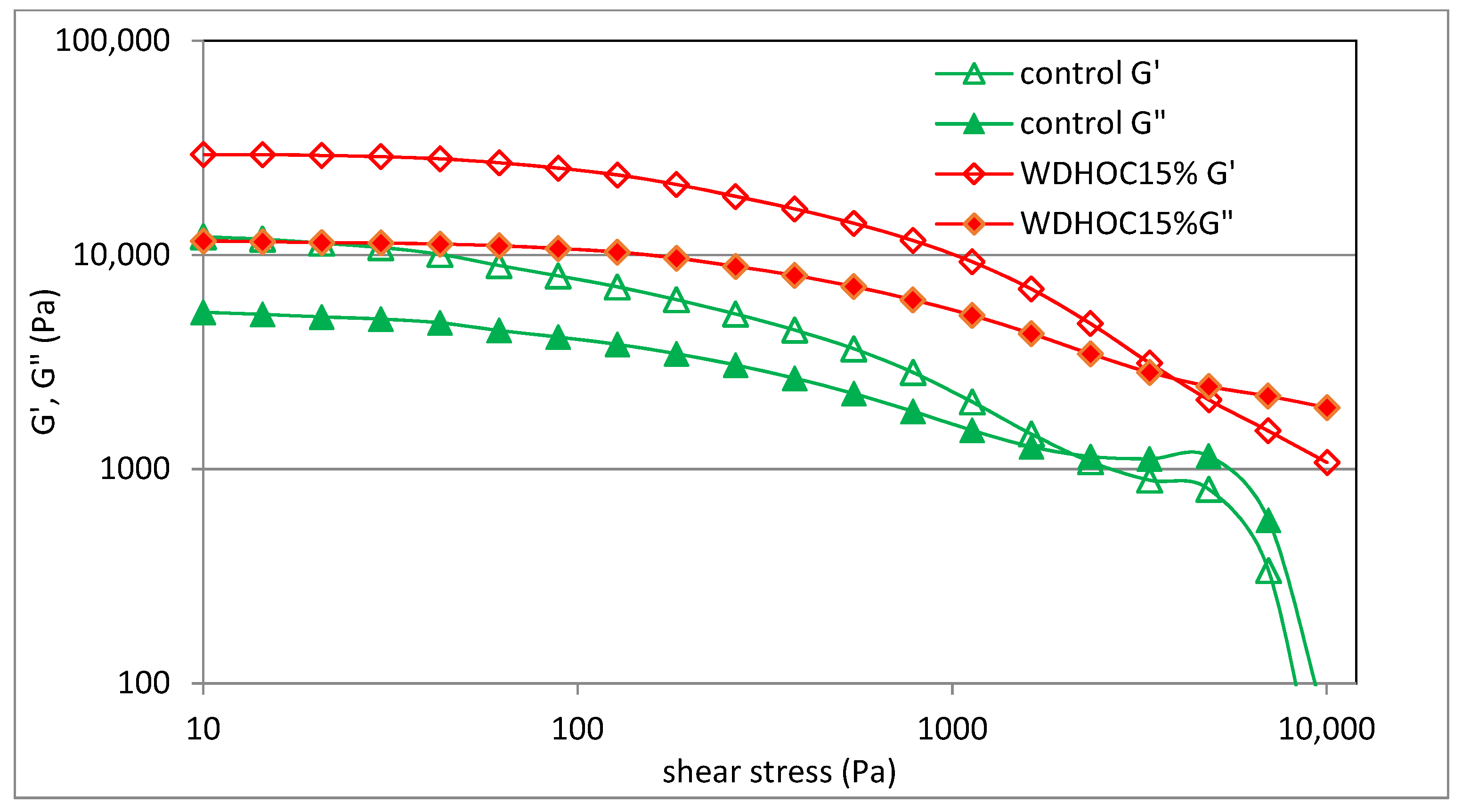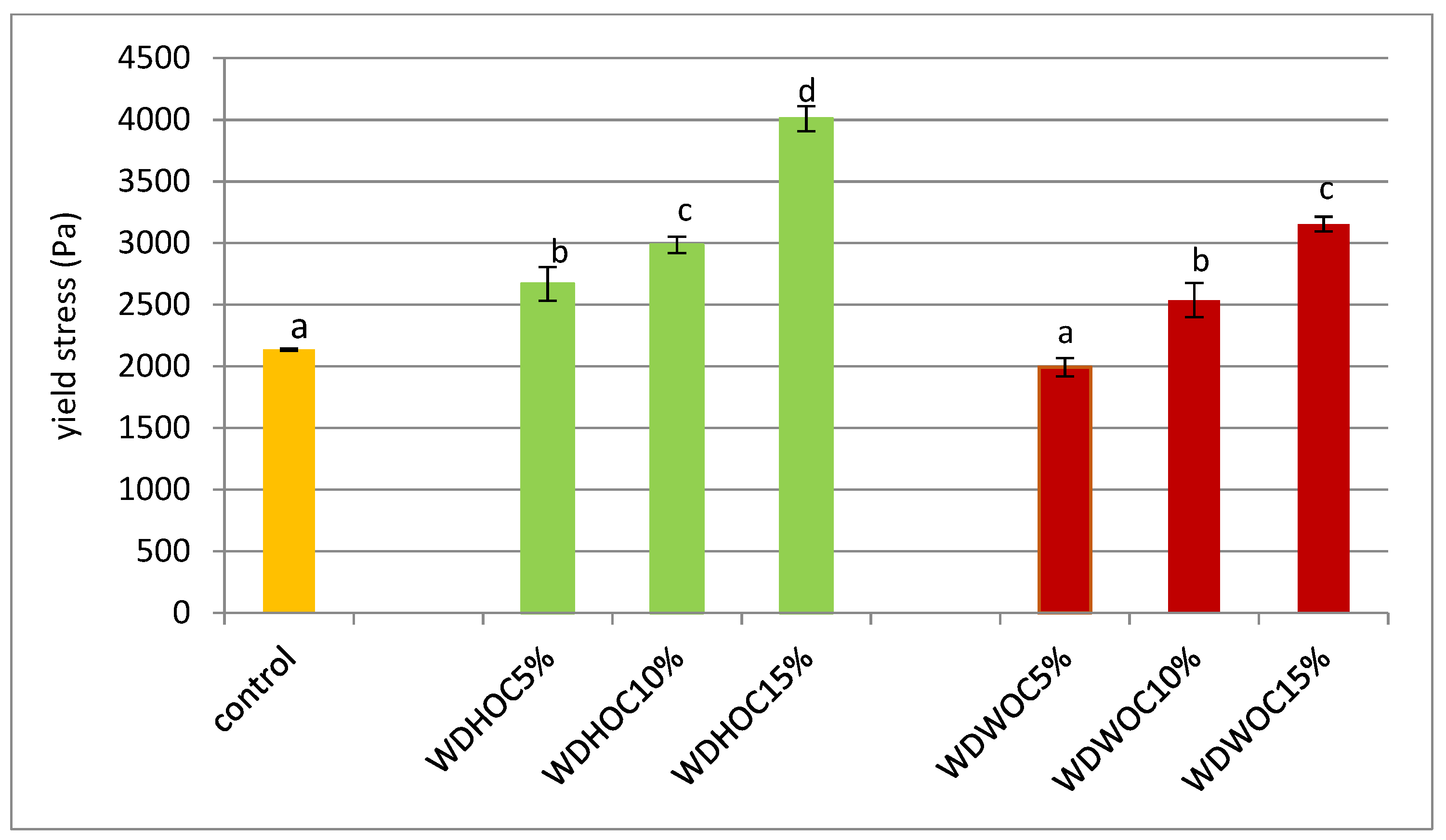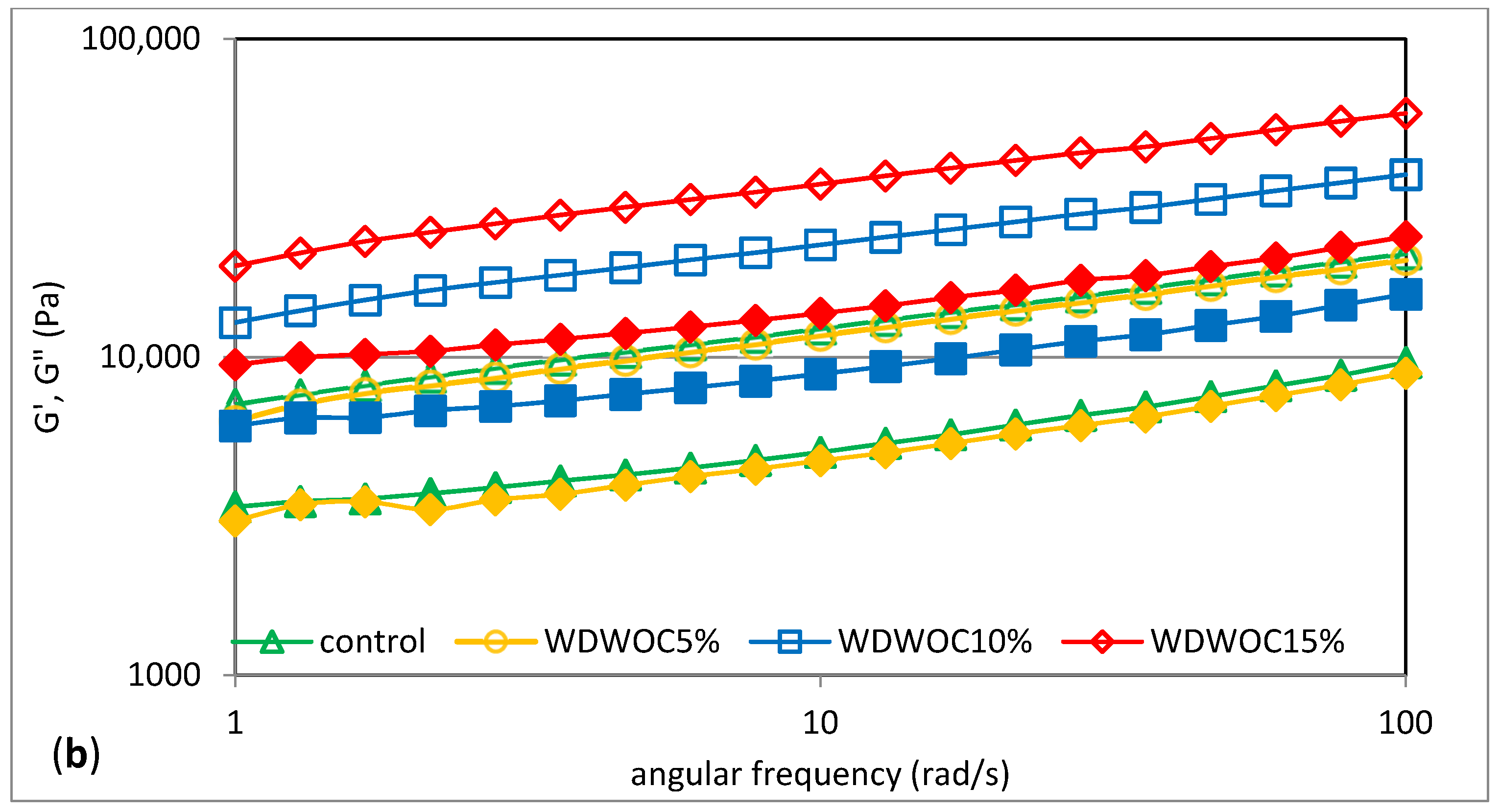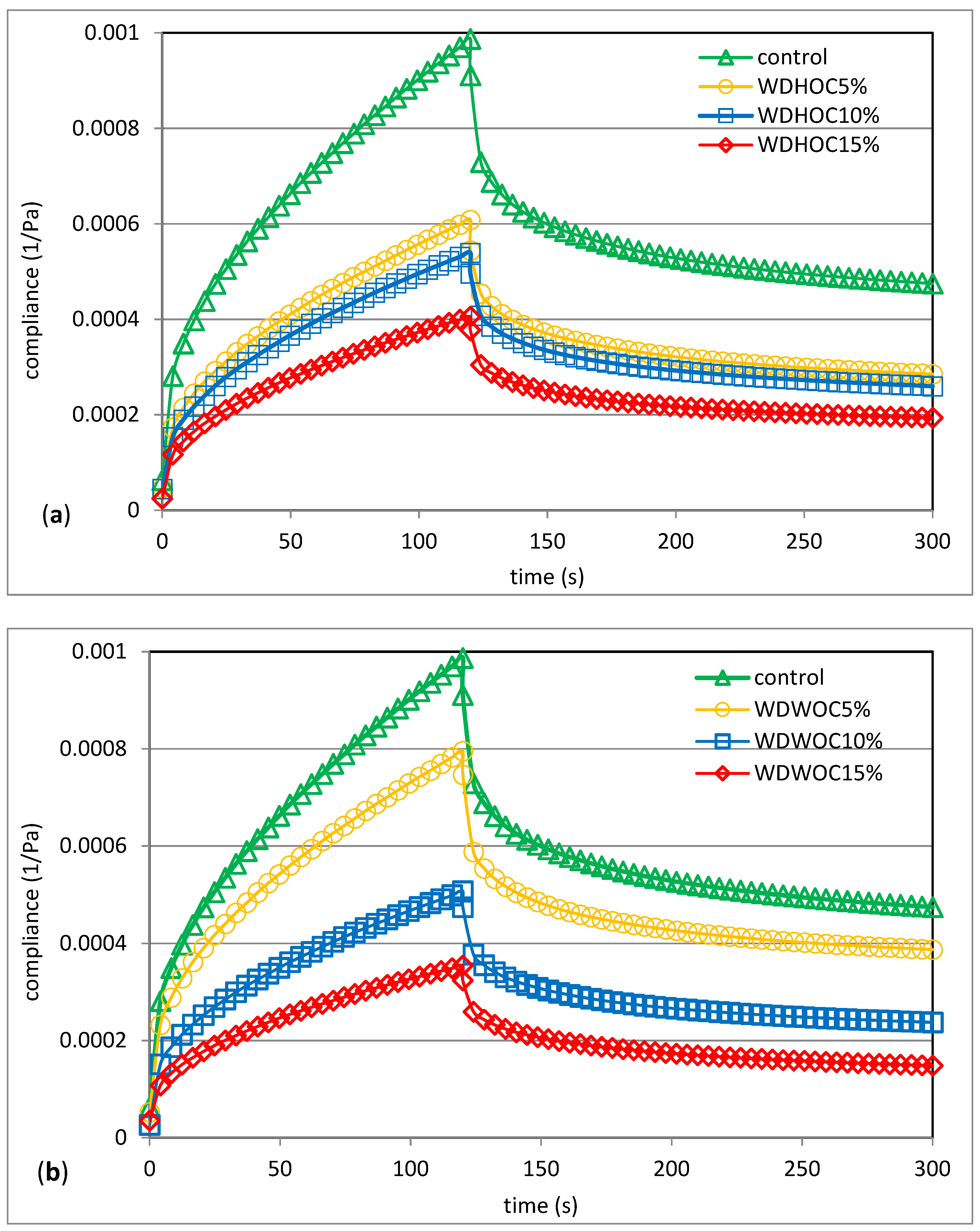Rheological Characteristics of Wheat Dough Containing Powdered Hazelnuts or Walnuts Oil Cakes
Abstract
:1. Introduction
2. Materials and Methods
2.1. Materials
2.2. Methods
2.2.1. Farinographic and Extensographic Analysis
2.2.2. Rheological Measurements
Determination of Yield Stress of Dough
Frequency Sweep Test
Creep and Recovery Test
2.2.3. Statistical Analysis
3. Results and Discussion
3.1. Farinograph Characteristics
3.2. Extensograph Characteristics
3.3. Yield Stress and Viscoelastics Properties of Doughs
3.4. Creep and Recovery Test
4. Conclusions
Author Contributions
Funding
Institutional Review Board Statement
Informed Consent Statement
Data Availability Statement
Conflicts of Interest
References
- Chwarścianek, F. Rheological properties of dough. Arch. Mech. Eng. 2006, 53, 123–153. [Google Scholar]
- Liu, Y.; Zhang, Q.; Wang, Y.; Xu, P.; Wang, L.; Liu, L.; Rao, Y. Enrichment of Wheat Bread with Platycodon grandiflorus Root (PGR) Flour: Rheological Properties and Microstructure of Dough and Physicochemical Characterization of Bread. Foods 2023, 12, 580. [Google Scholar] [CrossRef] [PubMed]
- Bloksma, A.H.; Bushuk, W. Rheology and chemistry of dough. In Wheat: Chemistry and Technology; Pomeranz, Y., Ed.; AACC International: St. Paul, MN, USA, 1988; pp. 131–217. [Google Scholar]
- Van Bockstaele, F.; De Leyn, I.; Eeckhout, M.; Dewettinck, K. Rheological Properties of Wheat Flour Dough and Their Relationship with Bread Volume. II. Dynamic Oscillation Measurements. Cereal Chem. 2008, 85, 762–768. [Google Scholar] [CrossRef]
- Pycia, K.; Kapusta, I.; Jaworska, G. Walnut oil and oilcake affect selected the physicochemical and antioxidant properties of wheat bread enriched with them. J. Food Process. Preserv. 2020, 44, e14573. [Google Scholar] [CrossRef]
- Bárta, J.; Bártová, V.; Jarošová, M.; Švajner, J.; Smetana, P.; Kadlec, J.; Filip, V.; Kyselka, J.; Berčíková, M.; Zdráhal, Z.; et al. Oilseed cake flour composition, functional properties and an-tioxidant potential as effects of sieving and species differences. Foods 2021, 10, 2766. [Google Scholar] [CrossRef] [PubMed]
- Pycia, K.; Juszczak, L. The Effect of the Addition of Hazelnut or Walnut Flour on the Rheological Characteristics of Wheat Dough. Materials 2022, 15, 782. [Google Scholar] [CrossRef] [PubMed]
- Pycia, K.; Juszczak, L. Influence of hazelnut and walnut oil cakes powder on thermal and rheological properties of wheat flour. Foods 2023, 12, 4060. [Google Scholar] [CrossRef]
- AACC. AACC. AACC Method 44-15.02. Moisture—Air-Oven Methods. In AACC Approved Methods of Analysis; Cereals & Grains Association: St. Paul, MN, USA, 2009. [Google Scholar]
- PN-ISO 5530-1:1999; Physical Properties of the Dough. Determination of Water Absorption and Rheological Properties Using a Farinograph. The Polish Committee for Standardization: Warsaw, Poland, 1999.
- PN-ISO 5530-2:2004; Wheat Flour. Physical Properties of the Dough. Part 2: Determination of Rheological Properties with an Extensograph. The Polish Committee for Standardization: Warsaw, Poland, 2004.
- Stojceska, V.; Butler, F. Digitization of farinogram plots and estimation of mixing stability. J. Cereal Sci. 2008, 48, 729–733. [Google Scholar] [CrossRef]
- Sarker, M.Z.I.; Yamauchi, H.; Kim, S.; Matsumura-Endo, C.; Takigawa, S.; Hashimoto, N.; Noda, T. A farinograph study on dough characteristics of mixtures of wheat flour and potato starches from different cultivars. Food Sci. Technol. Res. 2008, 14, 211–216. [Google Scholar] [CrossRef]
- Schmiele, M.; Jaekel, L.Z.; Patricio, S.M.C.; Steel, C.J.; Chang, Y.K. Rheological properties of wheat flour and quality characteristics of pan bread as modified by partial additions of wheat bran or whole grain wheat flour. Int. J. Food Sci. Technol. 2012, 47, 2141–2150. [Google Scholar] [CrossRef]
- Zaidul, I.S.M.; Karim, A.A.; Manan, D.M.A.; Ariffin, A.; Norulaini, N.A.N.; Omar, A.K.M. A farinograph study on the viscoelastic properties of sago/wheat flour dough. J. Sci. Food Agric. 2004, 84, 616–622. [Google Scholar] [CrossRef]
- Gómez, M.; Jiménez, S.; Ruiz, E.; Oliete, B. Effect of extruded wheat bran on dough rheology and bread quality. LWT Food Sci.Technol. 2011, 44, 2231–2237. [Google Scholar] [CrossRef]
- Wang, C.; Song, R.; Wei, S.; Wang, W.; Li, F.; Tang, X.; Li, N. Modification of insoluble dietary fiber from ginger residue through enzymatic treatments to improve its bioactive properties. LWT Food Sci. Technol. 2020, 125, 109220. [Google Scholar] [CrossRef]
- Li, R.; Wang, C.; Wang, Y.; Xie, X.; Sui, W.; Liu, R.; Wu, T.; Zhang, M. Extrusion Modification of Wheat Bran and Its Effects on Structural and Rheological Properties of Wheat Flour Dough. Foods 2023, 12, 1813. [Google Scholar] [CrossRef] [PubMed]
- Adamczyk, G.; Posadzka, Z.; Witczak, T.; Witczak, M. Comparison of the Rheological Behavior of Fortified Rye–Wheat Dough with Buckwheat, Beetroot and Flax Fiber Powders and Their Effect on the Final Product. Foods 2023, 12, 559. [Google Scholar] [CrossRef] [PubMed]
- Lauková, M.; Kohajdová, Z.; Karovičová, J.; Kuchtová, V.; Minarovičová, L.; Tomášiková, L. Effects of Cellulose Fiber with Different Fiber Length on Rheological Properties of Wheat Dough and Quality of Baked Rolls. Food Sci. Technol. Int. 2017, 23, 490–499. [Google Scholar] [CrossRef] [PubMed]
- Linlaud, N.E.; Puppo, M.C.; Ferrero, C. Effect of hydrocolloids on water absorption of wheat flour and farinograph and textural characteristics of dough. Cereal Chem. 2009, 86, 376–382. [Google Scholar] [CrossRef]
- Zhang, Y.; Hu, R.; Tilley, M.; Siliveru, K.; Li, Y. Effect of Pulse Type and Substitution Level on Dough Rheology and Bread Quality of Whole Wheat-Based Composite Flours. Processes 2021, 9, 1687. [Google Scholar] [CrossRef]
- Jakubczyk, T.; Haber, T. Analysis of Cereals and Cereal Products; SGGW Scripts: Warsaw, Poland, 1983. [Google Scholar]
- Achremowicz, B.; Biller, E.; Ceglińska, A.; Dardziński, L.; Haber, T.; Obiedzińska, A.; Obiedziński, M.; Szabłowska, E.; Waszkiewicz-Robak, B. The influence of the addition of Abyssinian milk seed flour on the physical properties of wheat dough. Postępy Tech. Przetwórstwa Spożywczego 2019, 1, 5–18. (In Polish) [Google Scholar]
- Sadowska, J.; Błaszczak, W.; Fornal, J.; Vidai-Valverde, C.; Frias, J. Changes of wheat dough and bread quality and structure as a result of germinated pea flour addition. Eur. Food Res. Technol. 2003, 216, 46–50. [Google Scholar] [CrossRef]
- Guardianelli, L.; Puppo, M.C.; Salinas, M.V. Influence of pistachio by-product from edible oil industry on rheological, hydration, and thermal properties of wheat dough. LWT Food Sci. Technol. 2021, 150, 111197. [Google Scholar] [CrossRef]
- Tarek-Tilistyáka, J.; Agócsb, J.; Lukácsc, M.; Dobró-Tótha, M.; Juhász-Románd, M.; Dinyaa, Z.; Jekőa, J.; Máthé; E. novel breads fortified through oilseed and nut cakes. Acta Aliment. 2014, 43, 444–451. [Google Scholar] [CrossRef]
- Shongwe, S.G.; Kidane, S.W.; Shelembe, J.S.; Nkambule, T.P. Dough rheology and physicochemical and sensory properties of wheat–peanut composite flour bread. Legume Sci. 2022, 4, e138. [Google Scholar] [CrossRef]
- Hussien, A.M.S.; Fouad, M.T.; El-Shenawy, M.A. Production of functional pan bread from mixture of tiger nut flour, milk permeate and hard wheat flour. Egypt. J. Chem. 2022, 65, 517–525. [Google Scholar] [CrossRef]
- Peng, Y.; Zhao, Y.; Jin, X.; Xiong, Y.; Dong, J.; Ma, W. Empirical and Theoretical Bases of Good Steamed Bread Production. Foods 2023, 12, 433. [Google Scholar] [CrossRef] [PubMed]
- Dokić, L.; Nikolić, I.; Šoronja-Simović, D.; Šereš, Z.; Krstonošić, V.; Fišteš, A. Physical properties of dough for cookies with chestnut flour. Analecta 2014, 1, 66–71. [Google Scholar]
- Dziubiński, M.; Kiljański, T.; Sęk, J. Podstawy Teoretyczne i Metody Pomiarowe Reologii; Wydawnictwo Politechniki Łódzkiej: Łódź, Poland, 2014; pp. 1–313. ISBN 978-83-7283-641-0. (In Polish) [Google Scholar]
- Ungureanu-Iuga, M.; Atudorei, D.; Codină, G.G.; Mironeasa, S. Rheological Approaches of Wheat Flour Dough Enriched with Germinated Soybean and Lentil. Appl. Sci. 2021, 11, 11706. [Google Scholar] [CrossRef]
- Dobraszczyk, B.J.; Morgenstern, M.P. Rheology and the breadmaking process. J. Cereal Sci. 2003, 38, 229–245. [Google Scholar] [CrossRef]
- Moelants, K.R.N.; Cardinaels, R.; Van Buggenhout, S.; Van Loey, A.M.; Moldenaers, P.; Hendrickx, M.E. A Review on the Relationships between Processing, Food Structure, and Rheological Properties of Plant-Tissue-Based Food Suspensions. Compr. Rev. Food Sci. Food Saf. 2014, 13, 241–260. [Google Scholar] [CrossRef]
- Korus, J.; Witczak, M.; Ziobro, R.; Juszczak, L. The Impact of Resistant Starch on Characteristics of Gluten-Free Dough and Bread. Food Hydrocoll. 2009, 23, 988–995. [Google Scholar] [CrossRef]
- Lazaridou, A.; Duta, D.; Papageorgiou, M.; Belc, N.; Biliaderis, C.G. Effects of hydrocolloids on dough rheology and bread quality parameters in gluten-free formulations. J. Food Eng. 2007, 79, 1033–1047. [Google Scholar] [CrossRef]
- Sivaramakrishnan, H.P.; Senge, B.; Chattopadhyay, P.K. Rheological properties of rice dough for making rice bread. J. Food Eng. 2004, 62, 37–45. [Google Scholar] [CrossRef]
- Steffe, J.F. Rheological Methods in Food Process Engineering, 2nd ed.; Freeman Press: East Lansing, MI, USA, 1996. [Google Scholar]
- Gałkowska, D.; Juszczak, L. Effects of amino acids on gelatinization, pasting and rheological properties of modified potato starches. Food Hydrocoll. 2019, 92, 143–154. [Google Scholar] [CrossRef]
- Onyango, C.; Mutungi, C.; Unbehend, G.; Lindhauer, M.G. Creep-recovery parameters of gluten-free batter and crumb properties of bread prepared from pregelatinised cassava starch, sorghum and selected proteins. Int. J. Food Sci. Technol. 2009, 44, 2493–2499. [Google Scholar] [CrossRef]
- Witczak, M.; Korus, J.; Ziobro, R.; Juszczak, L. Waxy starch as dough component and anti-staling agent in gluten-free bread. LWT-Food Sci. Technol. 2019, 99, 476–482. [Google Scholar] [CrossRef]
- Ostrowska-Maciejewska, J. Mechanics of Deformable Bodies; PWN Scientific Publishing House: Warsaw, Poland, 1994. (In Polish) [Google Scholar]
- Atudorei, D.; Mironeasa, S.; Codină, G.G. Dough Rheological Behavior and Bread Quality as Affected by Addition of Soybean Flour in a Germinated Form. Foods 2023, 12, 1316. [Google Scholar] [CrossRef]






| Sample | Water Absorption [%] | Dough Development Time [min] | Dough Stability [min] | Degree of Softening [BU] | Farinograph Number |
|---|---|---|---|---|---|
| control | 52.3 ± 1.0 a | 3.5 ± 1.1 a | 6.1 ± 0.6 a | 64.0 ± 16.5 d | 67.7 ± 7.8 a |
| WDHOC5% | 52.7 ± 0.3 a | 5.1 ± 0.1 bc | 7.5 ± 0.2 b | 35.7 ± 2.1 b | 89.0 ± 3.6 c |
| WDHOC10% | 53.8 ± 0.9 b | 4.3 ± 0.5 b | 5.9 ± 0.5 a | 67.0 ± 11.1 d | 74.3 ± 8.4 b |
| WDHOC15% | 52.8 ± 0.3 a | 4.7 ± 0.4 bc | 5.5 ± 0.4 a | 54.0 ± 4.6 c | 73.0 ± 3.0 b |
| WDWOC5% | 53.6 ± 0.2 ab | 4.2 ± 1.2 b | 9.0 ± 0.8 c | 31.7 ± 7.6 b | 94.0 ± 14.0 c |
| WDWOC10% | 53.7 ± 0.4 b | 6.0 ± 0.0 c | 13.6 ± 0.2 d | 17.3 ± 7.2 a | 122.3 ± 7.8 d |
| WDWOC15% | 53.8 ± 0.3 b | 7.5 ± 1.3 d | 13.7 ± 0.3 d | 7.3 ± 2.9 a | 150.0 ± 0.0 e |
| two-way ANOVA p-values | |||||
| Factor 1 | p < 0.001 | p < 0.001 | p < 0.001 | p < 0.001 | p < 0.001 |
| Factor 2 | p = 0.086 | p < 0.001 | p < 0.001 | p < 0.001 | p < 0.001 |
| Factor 1 × factor 2 | p = 0.136 | p < 0.001 | p < 0.001 | p < 0.001 | p < 0.001 |
| Sample | Energy [cm2] | Resistance to Extension [BU] | Extensibillity [mm] | ||||||
|---|---|---|---|---|---|---|---|---|---|
| 30 min | 60 min | 90 min | 30 min | 60 min | 90 min | 30 min | 60 min | 90 min | |
| control | 88.0 ± 5.7 bc | 82.5 ± 3.5 ab | 80.5 ± 4.9 ab | 324.0 ± 1.4 a | 341.5 ± 19.1 a | 334.5 ± 14.8 a | 159.0 ± 14.1 e | 145.5 ± 2.1 d | 147.0 ± 0.0 d |
| WDHOC5% | 98.0 ± 1.4 c | 98.5 ± 3.5 bc | 97.5 ± 2.1 b | 463.0 ± 9.9 b | 538.0 ± 7.1 c | 604.0 ± 21.2 bcd | 133.5 ± 0.7 c | 122.5 ± 3.5 c | 111.0 ± 1.4 b |
| WDHOC10% | 82.0 ± 2.8 b | 87.0 ± 5.7 ab | 83.5 ± 2.1 ab | 477.0 ± 15.6 b | 537.0 ± 32.5 c | 577.5 ± 30.4 bc | 115.0 ± 0.0 b | 111.5 ± 0.7 b | 104.0 ± 1.4 ab |
| WDHOC15% | 70.0 ± 2.8 a | 74.5 ± 3.5 a | 68.0 ± 5.7 a | 532.0 ± 5.7 c | 578.0 ± 9.9 c | 553.0 ± 31.1 b | 94.0 ± 1.4 a | 91.5 ± 2.1 a | 93.5 ± 12.0 a |
| WDWOC5% | 89.0 ± 0.0 bc | 103.5 ± 3.5 c | 125.5 ± 4.9 c | 346.0 ± 5.7 a | 426.5 ± 20.5 b | 311.5 ± 2.1 a | 152.0 ± 4.2 e | 147.5 ± 6.4 d | 191.0 ± 1.4 e |
| WDWOC10% | 110.0 ± 5.7 d | 131.5 ± 9.2 d | 133.0 ± 15.6 c | 468.0 ± 17.0 b | 401.0 ± 67.9 b | 669.0 ± 59.4 cd | 141.5 ± 2.1 d | 174.0 ± 7.1 e | 131.0 ± 1.4 c |
| WDWOC15% | 120.5 ± 7.8 d | 133.5 ± 6.4 d | 122.0 ± 4.2 c | 541.0 ± 19.8 c | 673.0 ± 25.5 d | 675.5 ± 46.0 d | 141.5 ± 3.5 d | 129.0 ± 2.8 c | 117.0 ± 4.2 b |
| two-way ANOVA p-values | |||||||||
| Factor 1 | p < 0.001 | p < 0.001 | p < 0.001 | p < 0.001 | p < 0.001 | p = 0.260 | p < 0.001 | p < 0.001 | p < 0.001 |
| Factor 2 | p = 0.713 | p = 0.197 | p = 0.041 | p < 0.001 | p < 0.001 | p < 0.001 | p < 0.001 | p < 0.001 | p < 0.001 |
| Factor 1 × factor 2 | p < 0.001 | p < 0.001 | p = 0.095 | p < 0.001 | p < 0.001 | p < 0.001 | p < 0.001 | p < 0.001 | p < 0.001 |
| Sample | Maximum [BU] | Ratio Number | ||||
|---|---|---|---|---|---|---|
| 30 min | 60 min | 90 min | 30 min | 60 min | 90 min | |
| control | 398.0 ± 5.7 a | 405.5 ± 21.9 a | 400.0 ± 14.1 a | 2.1 ± 0.2 a | 2.4 ± 0.2 a | 2.3 ± 0.1 b |
| WDHOC5% | 530.0 ± 4.2 cd | 593.0 ± 18.4 c | 646.0 ± 9.9 c | 3.5 ± 0.1 bc | 4.5 ± 0.1 b | 5.5 ± 0.2 c |
| WDHOC10% | 494.5 ± 19.1 c | 552.5 ± 37.5 bc | 586.0 ± 26.9 bc | 4.2 ± 0.1 d | 4.8 ± 0.3 bc | 5.6 ± 0.4 c |
| WDHOC15% | 532.5 ± 6.4 cd | 579.5 ± 9.2 bc | 553.5 ± 31.8 bc | 5.7 ± 0.1 e | 6.3 ± 0.0 d | 5.9 ± 0.4 c |
| WDWOC5% | 417.5 ± 9.2 b | 503.5 ± 7.8 b | 485.5 ± 16.3 b | 2.3 ± 0.1 a | 2.9 ± 0.3 a | 1.6 ± 0.0 a |
| WDWOC10% | 542.0 ± 17.0 cd | 548.5 ± 58.7 bc | 770.0 ± 67.9 d | 3.4 ± 0.1 b | 2.4 ± 0.5 a | 5.2 ± 0.5 c |
| WDWOC15% | 561.5 ± 46.0 d | 737.0 ± 17.0 d | 764.0 ± 62.2 d | 3.8 ± 0.3 c | 5.2 ± 0.3 c | 5.8 ± 0.6 c |
| two-way ANOVA p-values | ||||||
| Factor 1 | p = 0.381 | p = 0.272 | p < 0.001 | p < 0.001 | p < 0.001 | p < 0.001 |
| Factor 2 | p < 0.001 | p < 0.001 | p < 0.001 | p < 0.001 | p < 0.001 | p < 0.001 |
| Factor 1 × factor 2 | p < 0.001 | p < 0.001 | p < 0.001 | p < 0.001 | p = 0.398 | p < 0.001 |
| Sample | K′ [Pa sn′] | n′ | R2 | K″ [Pa sn″] | n″ | R2 |
|---|---|---|---|---|---|---|
| control | 7347.3 ± 515.6 b | 0.23 ± 0.01 ab | 0.9987 | 3121.0 ± 75.6 b | 0.23 ± 0.01 b | 0.9827 |
| WDHOC5% | 11,382.3 ± 479.0 c | 0.23 ± 0.01 ab | 0.9980 | 4898.7 ± 37.2 c | 0.22 ± 0.01 b | 0.9820 |
| WDHOC10% | 12,347.3 ± 717.4 c | 0.23 ± 0.00 ab | 0.9957 | 5268.7 ± 278.6 c | 0.22 ± 0.01 b | 0.9840 |
| WDHOC15% | 18,234.7 ± 525.2 e | 0.22 ± 0.01 a | 0.9967 | 7830.3 ± 290.0 e | 0.20 ± 0.00 a | 0.9783 |
| WDWOC5% | 6677.7 ± 121.0 a | 0.24 ± 0.01 b | 0.9957 | 2907.3 ± 61.5 a | 0.23 ± 0.01 b | 0.9730 |
| WDWOC10% | 13,436.7 ± 819.0 d | 0.22 ± 0.01 a | 0.9977 | 5749.3 ± 347.5 d | 0.20 ± 0.00 a | 0.9847 |
| WDWOC15% | 20,465.7 ± 694.6 f | 0.23 ± 0.01 ab | 0.9963 | 9000.3 ± 313.3 f | 0.20 ± 0.01 a | 0.9900 |
| two-way ANOVA p-values | ||||||
| Factor 1 | p = 0.130 | p = 0.483 | p = 0.360 | p = 0.839 | ||
| Factor 2 | p < 0.001 | p = 0.022 | p < 0.001 | p < 0.001 | ||
| Factor 1 × factor 2 | p < 0.001 | p = 0.079 | p < 0.001 | p = 0.042 | ||
| Sample | J0 (×10−4) (Pa−1) | J1 (×10−4) (Pa−1) | η0 (×104) (Pa·s) | λret (s) | R2 |
|---|---|---|---|---|---|
| control | 1.5 ± 0.2 e | 3.2 ± 0.2 e | 24.1 ± 1.0 a | 18.3 ± 1.6 ab | 0.9813 |
| WDHOC5% | 1.1 ± 0.0 d | 2.1 ± 0.1 c | 40.8 ± 1.7 b | 24.2 ± 2.0 cd | 0.9829 |
| WDHOC10% | 0.9 ± 0.0 c | 1.8 ± 0.0 b | 43.4 ± 3.3 b | 22.3 ± 3.0 bcd | 0.9818 |
| WDHOC15% | 0.6 ± 0.0 a | 1.4 ± 0.0 a | 58.0 ± 1.8 c | 20.8 ± 1.9 abc | 0.9797 |
| WDWOC5% | 1.2 ± 0.1 d | 2.8 ± 0.0 d | 29.1 ± 2.0 a | 16.8 ± 1.8 a | 0.9802 |
| WDWOC10% | 0.7 ± 0.0 b | 1.8 ± 0.0 b | 47.2 ± 2.9 b | 18.9 ± 2.3 ab | 0.9813 |
| WDWOC15% | 0.6 ± 0.0 a | 1.3 ± 0.0 a | 75.5 ± 7.5 d | 26.2 ± 2.6 d | 0.9818 |
| two-way ANOVA p-values | |||||
| Factor 1 | p = 0.623 | p < 0.001 | p = 0.103 | p = 0.120 | |
| Factor 2 | p < 0.001 | p < 0.001 | p < 0.001 | p = 0.070 | |
| Factor 1 × factor 2 | p = 0.056 | p < 0.001 | p < 0.001 | p < 0.001 | |
Disclaimer/Publisher’s Note: The statements, opinions and data contained in all publications are solely those of the individual author(s) and contributor(s) and not of MDPI and/or the editor(s). MDPI and/or the editor(s) disclaim responsibility for any injury to people or property resulting from any ideas, methods, instructions or products referred to in the content. |
© 2023 by the authors. Licensee MDPI, Basel, Switzerland. This article is an open access article distributed under the terms and conditions of the Creative Commons Attribution (CC BY) license (https://creativecommons.org/licenses/by/4.0/).
Share and Cite
Pycia, K.; Juszczak, L. Rheological Characteristics of Wheat Dough Containing Powdered Hazelnuts or Walnuts Oil Cakes. Foods 2024, 13, 140. https://doi.org/10.3390/foods13010140
Pycia K, Juszczak L. Rheological Characteristics of Wheat Dough Containing Powdered Hazelnuts or Walnuts Oil Cakes. Foods. 2024; 13(1):140. https://doi.org/10.3390/foods13010140
Chicago/Turabian StylePycia, Karolina, and Lesław Juszczak. 2024. "Rheological Characteristics of Wheat Dough Containing Powdered Hazelnuts or Walnuts Oil Cakes" Foods 13, no. 1: 140. https://doi.org/10.3390/foods13010140
APA StylePycia, K., & Juszczak, L. (2024). Rheological Characteristics of Wheat Dough Containing Powdered Hazelnuts or Walnuts Oil Cakes. Foods, 13(1), 140. https://doi.org/10.3390/foods13010140







